Initiation and maintenance of statins and aspirin after acute coronary syndromes (ANZACS-QI 11)
Andrew J. Kerr 1 , Mansi Turaga 2 , Corina Grey 3 , Mildred Lee 2 , Andrew McLachlan 2 , Gerry Devlin 41 Counties Manukau District Health Board; and University of Auckland, New Zealand
2 Counties Manukau District Health Board, New Zealand
3 Section of Epidemiology and Biostatistics, University of Auckland, New Zealand
4 Waikato District Health Board and University of Auckland, New Zealand; and National Heart Foundation, New Zealand
Correspondence to: Andrew J. Kerr, Department of Cardiology, Middlemore Hospital, Otahuhu, Auckland 93311, New Zealand. Email: Andrew.Kerr@middlemore.co.nz
Journal of Primary Health Care 8(3) 238-249 https://doi.org/10.1071/HC16013
Published: 20 September 2016
Journal Compilation © Royal New Zealand College of General Practitioners 2016.
This is an open access article licensed under a Creative Commons Attribution-NonCommercial-NoDerivatives 4.0 International License.
Abstract
INTRODUCTION: Prior New Zealand studies suggest that only approximately two-thirds of patients who present with an acute coronary syndrome (ACS) are maintained on a statin/aspirin post-discharge. This could be due to sub-optimal initiation or poor longer-term adherence.
AIM: To identify the pattern of statin/aspirin maintenance following ACS from initial prescription to 3 years post-discharge.
METHODS: All New Zealand Acute Coronary Syndrome Quality Improvement (ANZACS-QI) registry data for consecutive New Zealand residents (2007–2011), who were hospitalised with ACS, were anonymously linked to national datasets to derive a medication possession ratio (MPR) to assess medication maintenance. An MPR ≥ 0.8 is considered adequate maintenance.
RESULTS: Of the 1846 patients discharged alive, 95% were prescribed a statin at discharge and 92% were dispensed a statin within 3 months, but only 75% had a MPR ≥ 0.8 in the first year, and 67% in year 3. In the same cohort, 98% were prescribed aspirin and 88% were dispensed aspirin within the 3 months of discharge. In the first year, 72% had an aspirin MPR ≥ 0.8 and 71% maintained this in year 3. Fifty-nine percent were maintained on both aspirin and a statin in the third year, but 20% were maintained on neither. Regression analysis identified the independent predictors of inadequate maintenance in the third year as age < 45 years, no prior statin, and Māori and Pacific ethnicity.
CONCLUSION: Longer-term maintenance of evidenced-based secondary prevention medications after ACS is suboptimal despite high levels of initial prescribing and dispensing. Understanding the barriers to longer-term maintenance is required to improve patient outcomes.
KEYWORDS: Acute coronary syndromes; secondary prevention; statin; aspirin
| WHAT GAP THIS FILLS |
| What is already known: Prior New Zealand studies suggest that only approximately two-thirds of patients who present with an acute coronary syndrome (ACS) are maintained on a statin/aspirin post-discharge. This could be due to sub-optimal initiation or poor longer-term adherence. |
| What this study adds: Longer-term maintenance of evidenced-based secondary prevention medications after ACS is suboptimal despite high levels of initial prescribing and dispensing. |
Introduction
Over 15,000 patients are admitted to New Zealand (NZ) hospitals with an acute coronary syndrome (ACS) every year.1 There is robust evidence to support early initiation and long-term use of antiplatelet and statin medications to improve outcomes in patients after ACS,2–5 and poor adherence is associated with increased risk of rehospitalisation and mortality.6 A previous NZ national analysis reported that only two-thirds of patients who present with an ACS are adequately maintained on a statin in the three years post-discharge.7 However, it is not known whether this is due to sub-optimal initiation at the time of hospital discharge or poor longer-term maintenance. Furthermore, there is no published data in NZ on adherence to aspirin after ACS.
In NZ, the All New Zealand Acute Coronary Syndrome Quality Improvement (ANZACS-QI) registry captures data, including discharge prescriptions, on ACS patients. By anonymously linking ANZACS-QI registry data to national routine datasets, both initial medication dispensing and subsequent maintenance, can be tracked.8
The aim of this study was to better understand the relative importance of sub-optimal medication initiation versus poor longer-term maintenance after ACS. This will help inform quality improvement initiatives to improve secondary prevention medication management. The ANZACS-QI cohort was linked to national datasets to track the use of statins and aspirin following an ACS event, from initial prescribing and dispensing at the time of hospital discharge to subsequent maintenance up to three years post-discharge.
Methods
Cohort and data collection
The study cohort was identified from the ANZACS-QI registry. The registry is a web-based electronic database that captures a mandatory dataset that includes patient demographics, admission ACS risk stratification, cardiovascular risk factors, investigations and management, inpatient outcomes and medications prescribed at discharge. Details regarding data collection have previously been reported.8,9 The registry is subject to monthly auditing to ensure capture of > 95% of all patients admitted to coronary care units (CCUs), and an annual audit to check the accuracy of data entry.
For this study, at least three years of post-discharge follow-up time was required. This was available only for Middlemore and Waikato Hospital patients. The study cohort therefore comprised consecutive New Zealand residents aged 35–84 years who presented to those hospitals with a confirmed diagnosis of myocardial infarction (MI) or unstable angina from 4 August 2007 to 5 July 2011. Only the first admission for each patient in the time period was used. MI was defined according to the contemporary universal definition.10,11 Patients were excluded if they died within 90 days of discharge or spent less than 90 days out of hospital over the follow-up period. Medication dispensing data, hospitalisation and mortality data required for assessment of medication maintenance were obtained by individual linkage to routine national datasets, as previously described.12 An encrypted version of the National Health Index Number (NHI), a unique identifier assigned to everyone who uses health and disability support services (> 98% of the population),13 was used to anonymously link in-hospital ANZACS-QI patient records to the national datasets. The encryption and linkage methodology has previously been described.8
Data and definitions
Data collected in the ANZACS-QI registry has been previously described in detail.14 Variables used for this study included age, sex, ethnicity, prior statin use, diabetes, smoking status, history of cardiovascular disease (CVD), coronary intervention (coronary artery bypass grafting (CABG) or percutaneous coronary intervention (PCI) and a global measure of ACS risk (the Global Registry of ACS (GRACE) score).15 Sociodemographic variables and residency status were derived from the linked national dataset. For patients in whom more than one ethnic group was recorded, ethnicity was prioritised, in accordance with health sector protocols, in the following order: indigenous Māori, Pacific, Indian, and NZEO/other.16 Socioeconomic deprivation was assessed by the NZDep06 score, a census-based small area 10-point index of deprivation based on the person’s domicile.17 Prior statin use was obtained from the national pharmaceutical claims dataset and was defined as having a statin dispensed during the 90-day period before index admission.
Main outcome measure
Statin and aspirin use over a 3-year follow-up period was assessed by calculating a medication possession ratio (MPR).18 The MPR is the number of days the drug was assumed to be in a patient’s possession (based on dispensed drugs) divided by the number of days spent out of hospital from the date of hospital discharge through to the end of the follow-up period or the date of death, whichever came first. The possession of medications during 80% or more of follow-up time (i.e. MPR ≥ 0.8) was used to classify those adequately maintained on medications, as reported in other studies.6 We also considered MPR = 0, indicating no dispensing at all.
Ethics
Linkage of the ANZACS-QI and national datasets has been approved by the National Multi Region Ethics Committee (MEC/07/19/EXP).
Statistical analysis
A Chi-square test or Fisher’s exact test was used where appropriate to examine the association between categorical variables. Logistic regression modelling was used to assess the variables associated with the maintenance of statin and aspirin medication (MPR ≥ 0.8) in the third year. Variables entered into the model were age, gender, ethnicity, NZ Deprivation, hospitals, prior use of statin/aspirin, type of ACS, current smoker, diabetes, history of CVD, coronary procedure and Granger Grace score with a MPR ≥ 0.8 for statin and aspirin, respectively. The adjusted odds ratios are reported.
Statistical analysis was performed using SAS statistical software (SAS version 9.4; Cary, NC, USA).
Results
Cohort
Between 4 August 2007 and 5 July 2012, there were 1846 patients aged 35–84 years who survived at least 30 days post-discharge and had at least 3 years of follow up in the national datasets, and were admitted to Middlemore and Waikato Hospital CCUs. There were 1784 patients alive in the second year and 1723 in the third year (Table 1).
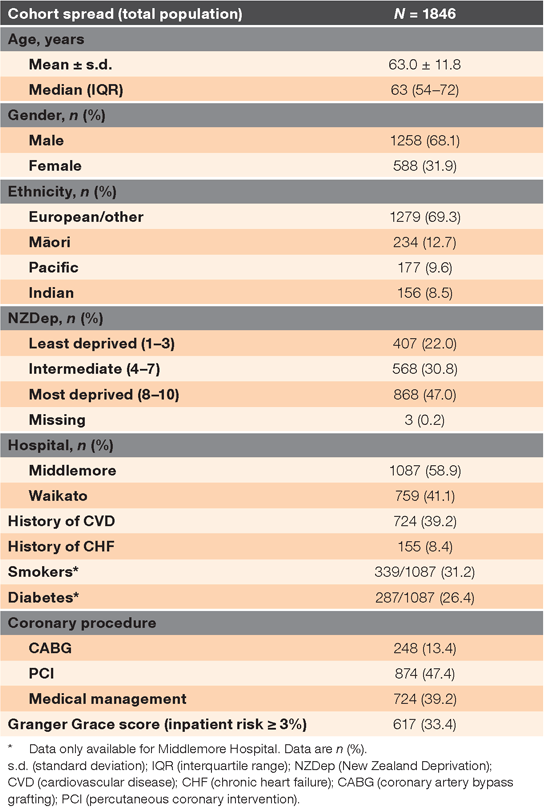
|
The mean age of patients was 63.0 years, with 68% male, 69% European/Other, 13% Māori, 10% Pacific and 9% Indian. Fifty-nine percent of the cohort was from the Middlemore region and 41% from the Waikato region.
Statin prescribing and dispensing
Ninety-five percent of the 1846 patients were prescribed a statin at discharge, and 92% were dispensed a statin within three months (Fig. 1). Statin prescribing at discharge was high across all ethnic groups (94–97%, P = 0.2687). Statin prescribing was slightly higher in men (96%) than women (92%) (P < 0.001). In those under 65 years of age, statin prescribing was 97%, while in those over the age of 65 years, it was 93% (P = 0.001) (Fig. 2). There were no differences in the prescribing of statins at discharge according to NZDep(06) classification (95%) (P = 0.843) (Table 2).
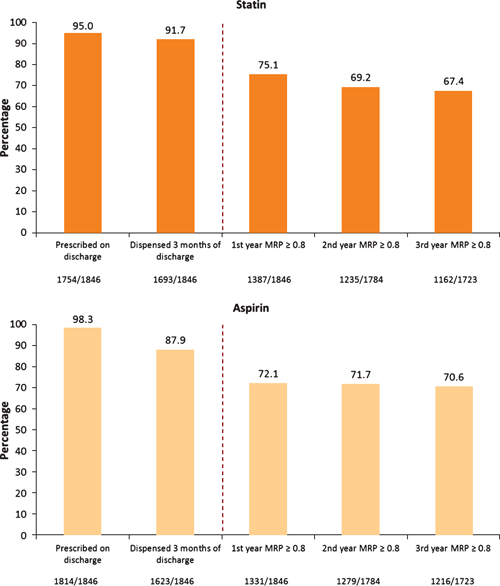
|
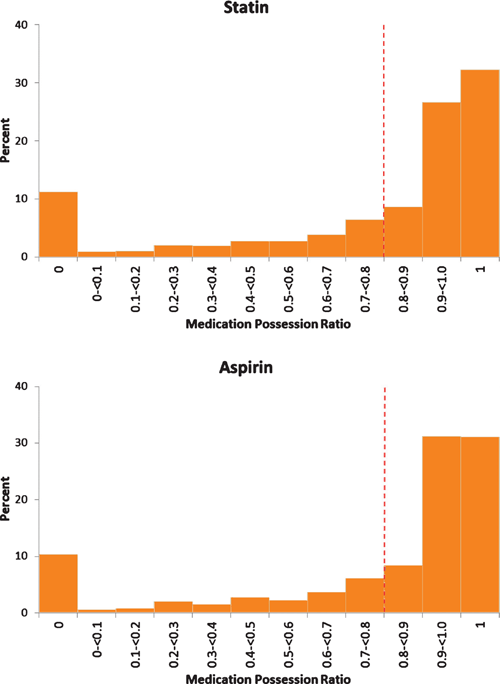
|

|
Overall, only 75% of patients had a MPR ≥ 0.8 in the first year, and this was maintained in only 67% of survivors in year 3. In year 3, 33% had an ideal MPR of 1, and 1 in 10 patients had no statin dispensed.
In the third year, the independent predictors of sub-optimal dispensing, by multi-variable logistic regression, were age < 45 years (P < 0.001), no prior use of statins (P < 0.001), medical management of coronary artery disease (P = 0.041), and Pacific (P < 0.001) and Māori (P = 0.012) ethnicity (Table 3).
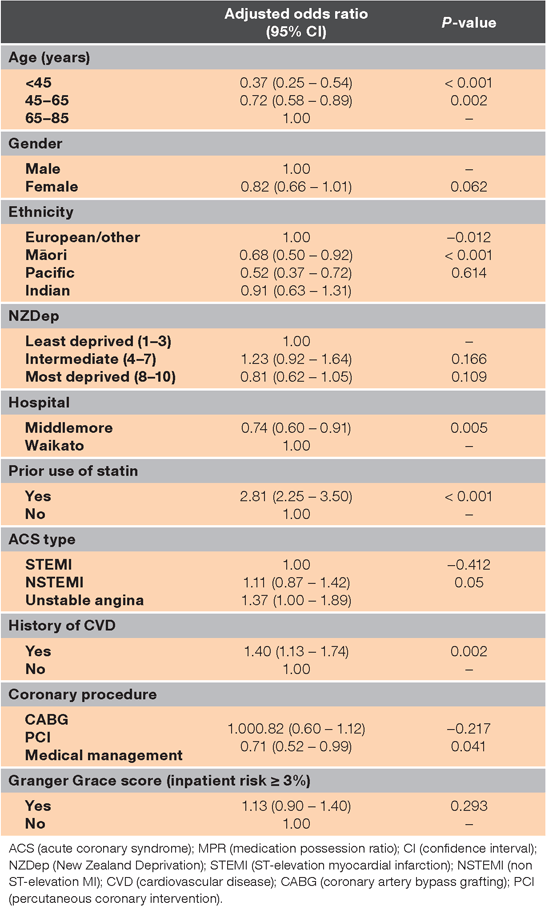
|
Aspirin prescribing and dispensing
Of the 1846 patients, 98% were prescribed aspirin and 88% had this dispensed within 3 months of discharge. Aspirin prescribing was similar among all ethnic groups (97–98%). Aspirin prescribing was similar regardless of age or gender. In the first year, 72.1% had a MPR ≥ 0.8, and 70.6% maintained this in year 3 (Appendix 1). In the third year, 1 in 10 patients were dispensed no aspirin.
In the third year, the independent predictors for inadequate maintenance were the same as for statins; age < 45 years (P < 0.001), no prior use of aspirin (P < 0.001), medical management of coronary artery disease (P = 0.028) and Pacific (P < 0.001) and Māori (P = 0.002) ethnicity (Appendix 2).
Comparison of aspirin and statin maintenance
In the third year post-discharge, 59% of patients were dispensed aspirin and statin consistently; 19% received either aspirin or statin, but 21% were not maintained on either (Table 4).

|
Discussion
Following an ACS admission, secondary prevention is key to reducing further ischaemic events following the index event. These events are common and in New Zealand, there is a one year case fatality of 21% following an ACS admission.1 As such, understanding secondary prevention practice and barriers to optimal care across the health continuum is essential to improve outcomes. In this study, we report high use of statins and aspirin, in over 90% of patients, at discharge post-ACS. Despite this, adequate maintenance of either medication was seen in only approximately three-quarters of patients in the first year post-discharge, and two-thirds in the third year. By the third year, only sixty percent were maintained on both a statin and aspirin, with one in five being maintained on neither medication.
The gap between the initial prescribing and dispensing of aspirin (98 vs 88%, respectively) was larger than that for statin (95 vs 92%, respectively). In NZ, aspirin, but not statin medication, is available over the counter without a prescription, which may account for this small difference. Despite this, it is cheaper for patients to obtain aspirin on prescription and it is routine practice to prescribe low-dose aspirin alongside other medications, so it is not surprising to find that the maintenance levels of aspirin and statin in the first and third years post-discharge are comparable.
The lower maintenance rates for statins in our cohort are similar to that found in a prior analysis using a NZ national ACS cohort. In a 2007 cohort studied by Grey et al., the reported statin MPRs were ≥ 0.8 in the first and third year post-ACS admission in 69% and 66% of patients, respectively.18 In a similar national cohort that included patients discharged after ACS, as well as those with angina, 59% of patients had a statin MPR at 1 year that was ≥ 0.8.19 That study provided a valuable insight into the possible reasons for patients not being maintained on a statin. In particular, it was reported that of the ~40% of patients with a MPR < 0.8, one-quarter was not dispensed any lipid-lowering drugs, one-quarter received alternative lipid-lowering drugs, one-quarter stopped statins, and the remaining one-quarter were intermittent statin users. Prior large observational studies have reported ~10% intolerance due to the statin-specific side-effects of myalgia and myopathy,20,21 and real or perceived intolerance to statins may explain these findings, so it is very unlikely that 30% of patients do not receive statins due to intolerance. This is supported by the finding in our study that 20% of patients were not adequately maintained on aspirin or a statin by year three. Aspirin intolerance is quite uncommon and we are not aware of any pathophysiological reason why aspirin and statin intolerance should coexist. As such, we believe it is highly unlikely that 20% of patients were intolerant to both aspirin and statins. Further support for this conclusion comes from our finding that in year 3, only 10% of patients were dispensed no statin (similar for aspirin), whereas 20% received some statin, but less than the MPR cut-off of 0.8. It is unlikely that by the third year many of those patients receiving intermittent statin or aspirin are truly intolerant, as intolerance is very likely to have been diagnosed in the first two years. These observations suggest that patient and practice factors other than medication intolerance are probably important for at least half of those not maintained on medication. This conclusion is further supported by the lower maintenance in particular groups, in particular younger patients and Māori and Pacific patients, in whom there is no known higher risk of statin intolerance.12
What are the predictors of maintenance?
The independent predictors of lower statin and aspirin maintenance in year 3 were similar and include age < 45 years, no prior use of the medication, medical management and Māori or Pacific ethnicity. In patients < 45 years, statins were prescribed in 97% and dispensed for 93% within 3 months. However, only 65% consistently received a statin in year 1, and this dropped off to 49% by year 3. This has been noted in previous studies.18 Young patients who have had an ACS event have the highest lifetime risk of a further cardiovascular event, and hence benefit the most from secondary prevention, but may mistakenly perceive themselves as being at lower risk due to their age.22
Despite the high rates of initial prescribing of statin and aspirin across the ethnic groups, the longer-term maintenance of both statin and aspirin was lower in Pacific and Māori people compared with other ethnic groups. The reasons for these ethnic differences are likely to be multifactorial, but may in part be related to differences in understanding of the benefits and risks of medications, language and/or cultural barriers that may lead to differential access to ongoing health care and health behaviours. In view of the disparity in outcomes for both Māori and Pacific patients after ACS,1 improving long-term medication management is an obvious target for the health system.
Clinical implications
Supporting longer-term medication management for ACS patients begins during the hospital admission and is supported by in-hospital and early post-discharge cardiac rehabilitation. In NZ, it then continues under the supervision of the primary care team. Continuation of medications of proven clinical benefit, which have been started in hospital, requires optimal performance across this care continuum. Important components include the involvement of the cardiac rehabilitation team while the patient is in hospital, attendance at culturally appropriate cardiac rehabilitation programmes after discharge, primary care-based medication adherence support and regular recalls by the primary care team to ensure re-prescription of medication continues after discharge.
Limitations
We used dispensing of statin and aspirin as a marker of maintenance, but not everyone who is dispensed a drug routinely is necessarily taking the medication. We have also not taken into account the dosing and type of statin used, but we did include anyone who is on a statin regardless of type or dosage. In addition, there may be a low number of patients who are appropriately changed to another anti-platelet agent or an anti-coagulant medication late after discharge.
Conclusion
Longer-term maintenance of evidenced-based secondary prevention medications after ACS events is suboptimal despite high levels of initial prescribing and dispensing. Initiatives to improve our understanding of the barriers to care across the health continuum, with emphasis on post-discharge care, are required to improve patient outcomes.
ACKNOWLEDGEMENTS
Our thanks go to the medical and nursing staff at Middlemore and Waikato Hospitals for entering the ANZACS-QI registry data, and to the National Health Board Analytic Services and Pharmac for enabling use of the national datasets. The ANZACS-QI software was developed and supported by Enigma Solutions (Auckland, New Zealand).
References
[1] Grey C, Jackson R, Wells S, et al. Twenty-eight day and one-year case fatality after hospitalisation with an acute coronary syndrome: a nationwide data linkage study. Aust N Z J Public Health. 2014; 38 216–20.| Twenty-eight day and one-year case fatality after hospitalisation with an acute coronary syndrome: a nationwide data linkage study.Crossref | GoogleScholarGoogle Scholar | 24890478PubMed |
[2] Antithrombotic Trialists’ (ATT) Collaboration Aspirin in the primary and secondary prevention of vascular disease: collaborative meta-analysis of individual participant data from randomised trials. Lancet 2009; 373 1849–60.
| Aspirin in the primary and secondary prevention of vascular disease: collaborative meta-analysis of individual participant data from randomised trials.Crossref | GoogleScholarGoogle Scholar | 19482214PubMed |
[3] Cholesterol Treatment Trialists’ (CTT) Collaborators The effects of lowering LDL cholesterol with statin therapy in people at low risk of vascular disease: meta-analysis of individual data from 27 randomised trials. Lancet 2012; 380 581–90.
| The effects of lowering LDL cholesterol with statin therapy in people at low risk of vascular disease: meta-analysis of individual data from 27 randomised trials.Crossref | GoogleScholarGoogle Scholar | 22607822PubMed |
[4] Cholesterol Treatment Trialists’ (CTT) Collaborators Efficacy and safety of cholesterol-lowering treatment: prospective meta-analysis of data from 90,056 participants in 14 randomised trials of statins. Lancet 2005; 366 1267–78.
| Efficacy and safety of cholesterol-lowering treatment: prospective meta-analysis of data from 90,056 participants in 14 randomised trials of statins.Crossref | GoogleScholarGoogle Scholar | 16214597PubMed |
[5] Afilalo J, Duque G, Steele R, et al. Statins for secondary prevention in elderly patients: a hierarchical bayesian meta-analysis. J Am Coll Cardiol. 2008; 51 37–45.
| Statins for secondary prevention in elderly patients: a hierarchical bayesian meta-analysis.Crossref | GoogleScholarGoogle Scholar | 1:CAS:528:DC%2BD1cXislCrtQ%3D%3D&md5=e468af39b4c6c41e6c0fd57f1b5c9da5CAS | 18174034PubMed |
[6] Ho PM, Bryson CL, Rumsfeld JS. Medication adherence: its importance in cardiovascular outcomes. Circulation 2009; 119 3028–35.
| Medication adherence: its importance in cardiovascular outcomes.Crossref | GoogleScholarGoogle Scholar | 19528344PubMed |
[7] Grey C, Jackson R, Wells S, et al. Maintenance of statin use over 3 years following acute coronary syndromes: a national data linkage study (ANZACS-QI-2). Heart 2014; 100 770–4.
| Maintenance of statin use over 3 years following acute coronary syndromes: a national data linkage study (ANZACS-QI-2).Crossref | GoogleScholarGoogle Scholar | 1:CAS:528:DC%2BC2cXhtVKnu7rO&md5=1ec868082f915d00ea07d377ebd1d012CAS | 24436219PubMed |
[8] Kerr AJ, Looi JL, Garofalo D, et al. Acute Predict: a clinician-led cardiovascular disease quality improvement project (Predict-CVD 12). Heart Lung Circ. 2010; 19 378–83.
| Acute Predict: a clinician-led cardiovascular disease quality improvement project (Predict-CVD 12).Crossref | GoogleScholarGoogle Scholar | 20392667PubMed |
[9] Kerr AJ, Lin A, Lee M, et al. Risk stratification and timing of coronary angiography in acute coronary syndromes: are we targeting the right patients in a timely manner? (ANZACS-QI 1). N Z Med J. 2013; 126 69–80.
| 24362735PubMed |
[10] Thygesen K, Alpert JS, Jaffe AS, et al. Third universal definition of myocardial infarction. Eur Heart J. 2012; 33 2551–67.
| Third universal definition of myocardial infarction.Crossref | GoogleScholarGoogle Scholar | 22922414PubMed |
[11] Thygesen K, Alpert JS, White HD. Universal definition of myocardial infarction. Eur Heart J. 2007; 28 2525–38.
| Universal definition of myocardial infarction.Crossref | GoogleScholarGoogle Scholar | 17951287PubMed |
[12] Kerr A, Exeter D, Hanham G, et al. Effect of age, gender, ethnicity, socioeconomic status and region on dispensing of CVD secondary prevention medication in New Zealand: the Atlas of Health Care Variation CVD cohort (VIEW-1). N Z Med J. 2014; 127 39–69.
| 25145366PubMed |
[13] Ministry of Health. National Health Index data dictionary (version 5.3). Wellington, New Zealand: Ministry of Health; 2009.
[14] Kerr AJ, Mustafa A, Lee M, et al. Ethnicity and revascularisation following acute coronary syndromes: a 5-year cohort study (ANZACS-QI-3). N Z Med J. 2014; 127 38–51.
| 24816955PubMed |
[15] Granger CB, Goldberg RJ, Dabbous O, et al. Global Registry of Acute Coronary Events I. Predictors of hospital mortality in the global registry of acute coronary events. Arch Intern Med. 2003; 163 2345–53.
| Global Registry of Acute Coronary Events I. Predictors of hospital mortality in the global registry of acute coronary events.Crossref | GoogleScholarGoogle Scholar | 14581255PubMed |
[16] Ministry of Health. Ethnicity data protocols for the health and disability sector. Wellington, New Zealand: MOH; 2004.
[17] Salmond C, Crampton P, Atkinson J. NZDep2006 index of deprivation. Wellington: Department of Public Health, Wellington School of Medicine and Health Sciences; 2007.
[18] Grey C, Jackson R, Wells S, et al. Maintenance of statin use over 3 years following acute coronary syndromes: a national data linkage study (ANZACS-QI-2). Heart 2003; 100 770–4.
| Maintenance of statin use over 3 years following acute coronary syndromes: a national data linkage study (ANZACS-QI-2).Crossref | GoogleScholarGoogle Scholar |
[19] Thornley S, Marshall R, Chan WC, et al. Four out of ten patients are not taking statins regularly during the 12 months after an acute coronary event. Eur J Prev Cardiol. 2012; 19 349–57.
| Four out of ten patients are not taking statins regularly during the 12 months after an acute coronary event.Crossref | GoogleScholarGoogle Scholar | 21450568PubMed |
[20] Bruckert E, Hayem G, Dejager S, et al. Mild to moderate muscular symptoms with high-dosage statin therapy in hyperlipidemic patients–the PRIMO study. Cardiovasc Drugs Ther. 2005; 19 403–14.
| Mild to moderate muscular symptoms with high-dosage statin therapy in hyperlipidemic patients–the PRIMO study.Crossref | GoogleScholarGoogle Scholar | 1:CAS:528:DC%2BD28XhtlGku7w%3D&md5=0b3d7b3e98d48f5bc8e23a4e75a1ab13CAS | 16453090PubMed |
[21] Nichols GA, Koro CE. Does statin therapy initiation increase the risk for myopathy? An observational study of 32,225 diabetic and nondiabetic patients. Clin Ther. 2007; 29 1761–70.
| Does statin therapy initiation increase the risk for myopathy? An observational study of 32,225 diabetic and nondiabetic patients.Crossref | GoogleScholarGoogle Scholar | 1:CAS:528:DC%2BD2sXhtFyjt7nP&md5=d64e0dbfff1f10c86a13aebab14a5864CAS | 17919557PubMed |
[22] Kerr A, Exeter DJ, Hanham G, et al. Effect of age, gender, ethnicity, socioeconomic status and region on dispensing of CVD secondary prevention medication in New Zealand: the Atlas of Health Care Variation CVD cohort (VIEW-1) N Z Med J. 2014; 127 39–69.
| 25145366PubMed |

|
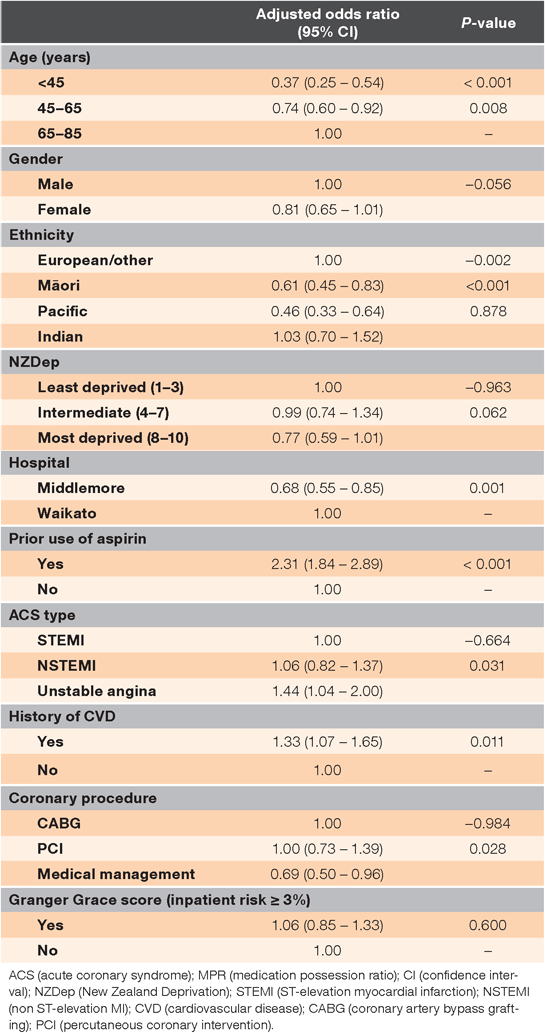
|


